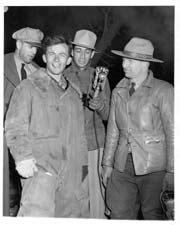|
In October 1941 Devils Tower National Monument made headlines across the nation. A professional parachutist named George Hopkins was stuck atop the Tower with no way down. Who was this person, why was he on Devils Tower, and how was he going to down? During the first part of the 1900s, several advancements in parachute technology had been made; the devices were still rudimentary by today's standards, however. George Hopkins already held a number of records for spectacular parachute jumps, but he looked to push the envelope even further. He wanted to set a world record for number of parachute jumps in a single day. To create publicity for this idea, he determined a single, spectacular jump would do the trick. Without the consent or knowledge of National Park Service officials, Hopkins parachuted from an airplane to the top of Devils Tower. He wanted to prove that a parachutist could land precisely on a small target - the Tower summit being just over one acre in size. His plan was to descend using a 1,000-foot rope which would be dropped from the plane after him. Hopkins hit his mark, but his rope landed out of reach on the side of the Tower, leaving him stuck on top. 
The National Park Service now had a problem to solve, and newspapers around the country ran with the story. While they considered options for rescuing the stranded man, airplanes dropped food, water and warm clothing to keep Hopkins alive. Letters written by concerned citizens, corporations and the military posed uncertain suggestions for getting him down. After a few days Jack Durrance, one of the early technical climbers to scale the Tower, offered to lead a rescue party. The park service accepted. More supplies were dropped to Hopkins and assurances were given that help was coming. Advice and offers of assistance continued. The Goodyear Company offered to loan the use of a blimp, while the Navy offered the use of a helicopter. Bad weather forced Durrance to travel by train. On October 5, Durrance and his party arrived at the monument. Working closely with the park service, they laid out a safe climbing route for rescue operations. On the following day, Durrance led seven other climbers to the summit of the Tower. They found Hopkins who, in spite of his ordeal, was in excellent physical condition and in good spirits. The descent was made with little difficulty. The stranded parachutist and the rescue operations attracted many spectators: during the six-day period, some 7,000 visitors came to the monument to witness events first-hand. Within a few months following the Hopkins episode, the United States entered World War II. National Park Service sites saw very little visitation during the war years. As for Hopkins, he would go on to work with the military training the new airborne infantry divisions for the war. It is believed he set his world record as he taught other young men to safely jump and land using a parachute. |
Last updated: April 24, 2025
